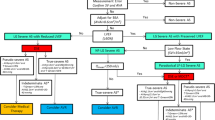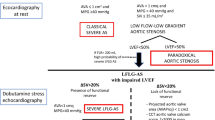Abstract
A substantial proportion of patients with severe aortic stenosis may paradoxically have low transvalvular flow and a low gradient, despite the presence of normal left ventricular (LV) ejection fraction. These patients are characterized by pronounced LV concentric remodeling with small LV cavity size, impaired LV filling, altered myocardial function, and worse prognosis. This frequent clinical entity is often misdiagnosed, which may lead to an underestimation of aortic stenosis severity and thereby to underutilization or inappropriate delay of surgery. It is important to recognize this entity so we do not deny surgery to a symptomatic patient with small aortic valve area and low gradient. Thus, when there is a discordance between the valve area (in the severe range) and the gradient (in the moderate range) in patients with preserved LV ejection fraction, a more comprehensive Doppler echocardiographic evaluation and potentially other diagnostic tests may be required to confirm disease severity and guide therapeutic management.


Similar content being viewed by others
References
Papers of particular interest, published recently, have been highlighted as follows: •Of importance ••Of major importance
Vahanian A, Baumgartner H, Bax J, et al.: Guidelines on the management of valvular heart disease: the Task Force on the Management of Valvular Heart Disease of the European Society of Cardiology. Eur Heart J 2007, 28:230–268.
Bonow RO, Carabello BA, Kanu C, et al.: ACC/AHA 2006 guidelines for the management of patients with valvular heart disease: a report of the American College of Cardiology/American Heart Association Task Force on Practice Guidelines. Circulation 2006, 114:e84–e231.
Monin JL, Quere JP, Monchi M, et al.: Low-gradient aortic stenosis: operative risk stratification and predictors for long-term outcome: a multicenter study using dobutamine stress hemodynamics. Circulation 2003, 108:319–324.
Clavel MA, Fuchs C, Burwash IG, et al.: Predictors of outcomes in low-flow, low-gradient aortic stenosis: results of the multicenter TOPAS Study. Circulation 2008, 118:S234–S242.
deFilippi CR, Willett DL, Brickner ME, et al.: Usefulness of dobutamine echocardiography in distinguishing severe from nonsevere valvular aortic stenosis in patients with depressed left ventricular function and low transvalvular gradients. Am J Cardiol 1995, 75:191–194.
Blais C, Dumesnil JG, Baillot R, et al.: Impact of prosthesis-patient mismatch on short-term mortality after aortic valve replacement. Circulation 2003, 108:983–988.
Kulik A, Burwash IG, Kapila V, et al.: Long-term outcomes after valve replacement for low-gradient aortic stenosis: impact of prosthesis-patient mismatch. Circulation 2006, 114(Suppl I):I5553–I5558.
Tribouilloy C, Levy F, Rusinaru D, et al.: Outcome after aortic valve replacement for low-flow/low-gradient aortic stenosis without contractile reserve on dobutamine stress echocardiography. J Am Coll Cardiol 2009, 53:1865–1873.
•• Hachicha Z, Dumesnil JG, Bogaty P, Pibarot P: Paradoxical low flow, low gradient severe aortic stenosis despite preserved ejection fraction is associated with higher afterload and reduced survival. Circulation 2007, 115:2856–2864. This is the first study to describe this new clinical entity of paradoxical low-flow, low-gradient severe AS with preserved LVEF. This is probably the article in this list that should be read in priority when one wants to learn more about this particular topic.
• Cramariuc D, Cioffi G, Rieck AE, et al.: Low-flow aortic stenosis in asymptomatic patients: valvular arterial impedance and systolic function from the SEAS substudy. JACC Cardiovasc Imaging 2009, 2:390–399. This is an important study that confirms the results of Hachicha et al. [9••] in a large prospective series of asymptomatic patients.
Pibarot P, Dumesnil JG: Aortic stenosis: look globally, think globally. JACC Cardiovasc Imaging 2009, 2:400–403.
• Dumesnil JG, Pibarot P, Carabello B: Paradoxical low flow and/or low gradient severe aortic stenosis despite preserved left ventricular ejection fraction: implications for diagnosis and treatment. Eur Heart J 2010, 31:281–289. This is an interesting viewpoint article of paradoxical low-flow, low-gradient AS. It also provides important additional results of the study by Hachicha et al. [9••].
• Barasch E, Fan D, Chukwu EO, et al.: Severe isolated aortic stenosis with normal left ventricular systolic function and low transvalvular gradients: pathophysiologic and prognostic insights. J Heart Valve Dis 2008, 17:81–88. This is an important study showing that patients with normal LVEF, low-flow, low-gradient. AS have a 50% lower referral to surgery but a twofold increase in mortality.
•• Weidemann F, Herrmann S, Stork S, et al.: Impact of myocardial fibrosis in patients with symptomatic severe aortic stenosis. Circulation 2009, 120:577–584. This is a very important and comprehensive study showing that patients with small AVA, normal LVEF, and low gradient have more myocardial fibrosis and reduced myocardial systolic function.
Strotmann JM, Lengenfelder B, Blondelot J, et al.: Functional differences of left ventricular hypertrophy induced by either arterial hypertension or aortic valve stenosis. Am J Cardiol 2008, 101:1493–1497.
• Hachicha Z, Dumesnil JG, Pibarot P: Usefulness of the valvuloarterial impedance to predict adverse outcome in asymptomatic aortic stenosis. J Am Coll Cardiol 2009, 54:1003–1011. This is an important study that demonstrates the usefulness of the valvuloarterial impedance to estimate the global hemodynamic load and to predict outcomes in patients with AS.
Gerdts E: Left ventricular structure in different types of chronic pressure overload. Eur Heart J 2008, 10(Suppl. E):E23–E30.
Pagé A, Dumesnil JG, Clavel MA, et al.: Metabolic syndrome is associated with more pronounced impairment of LV geometry and function in patients with calcific aortic stenosis: a substudy of the ASTRONOMER trial. J Am Coll Cardiol 2009 (in press).
Dumesnil JG, Shoucri RM: Quantitative relationships between left ventricular ejection and wall thickening and geometry. J Appl Physiol 1991, 70:48–54.
Briand M, Dumesnil JG, Kadem L, et al.: Reduced systemic arterial compliance impacts significantly on left ventricular afterload and function in aortic stenosis: implications for diagnosis and treatment. J Am Coll Cardiol 2005, 46:291–298.
Pai RG, Varadarajan P, Razzouk A: Survival benefit of aortic valve replacement in patients with severe aortic stenosis with low ejection fraction and low gradient with normal ejection fraction. Ann Thorac Surg 2008, 86:1781–1789.
Dumesnil JG, Dion D, Yvorchuk K, et al.: A new, simple and accurate method for determining ejection fraction by Doppler echocardiography. Can J Cardiol 1995, 11:1007–1014.
Garcia D, Kadem L: What do you mean by aortic valve area: geometric orifice area, effective orifice area, or gorlin area? J Heart Valve Dis 2006, 15:601–608.
•• Minners J, Allgeier M, Gohlke-Baerwolf C, et al.: Inconsistencies of echocardiographic criteria for the grading of aortic valve stenosis. Eur Heart J 2008, 29:1043–1048. This is a very important study showing that there are inconsistencies in the criteria of AVA and mean gradient proposed in the guidelines to grade severe AS.
Orsinelli DA, Aurigemma GP, Battista S, et al.: Left ventricular hypertrophy and mortality after aortic valve replacement for aortic stenosis. A high risk subgroup identified by preoperative relative wall thickness. J Am Coll Cardiol 1993, 22:1679–1683.
Duncan AI, Lowe BS, Garcia MJ, et al.: Influence of concentric left ventricular remodeling on early mortality after aortic valve replacement. Ann Thorac Surg 2008, 85:2030–2039.
Aortic valve calcification measured by multislice computed tomography in aortic stenosis - correlation with hemodynamic severity and clinical implication for patients with low ejection fraction. Cueff C, Serfaty JM, Cimadevilla C, et al. Eurecho 2009. Madrid December 10, 2009. Eur J Echocardiogr 2009, 10: ii45-ii73 [Abstract].
Acknowledgment
Dr. Philippe Pibarot holds the Canada Research Chair in Valvular Heart Disease, Canadian Institutes of Health Research (CIHR), Ottawa, Ontario, Canada. This work is funded by a research grant (#MOP 57445) from CIHR.
Disclosure
No potential conflicts of interest relevant to this article were reported.
Author information
Authors and Affiliations
Corresponding author
Rights and permissions
About this article
Cite this article
Pibarot, P., Dumesnil, J.G. Low-Flow, Low-Gradient, Normal Ejection Fraction Aortic Stenosis. Curr Cardiol Rep 12, 108–115 (2010). https://doi.org/10.1007/s11886-010-0090-0
Published:
Issue Date:
DOI: https://doi.org/10.1007/s11886-010-0090-0




